Are you a person looking for a classical 2D Japanese style RPG on iOS? Would you prefer the game have production standards more resembling an actual console effort, rather than the quality normally seen in an RPG released on the iOS (which, ignoring screen resolution and color depth, tend to be on par with an ancient NES game)? Would you like to add on top of all this more than an hour of hand animated cut scenes, as well as competent voice acting done by professionals? Finally, would you be even more happy still if the game was utterly devoid of whiny spiky-haired emo protagonists?
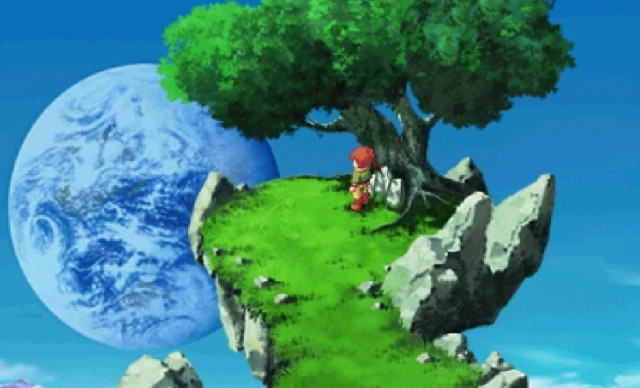 SoMoGa’s recent release of Lunar: Silver Star Story Touch (out now, $6.99) — a virtually straight port of the similarly named PS1 classic — does everything I have promised, as well as so much more. In fact, those of you who loved playing the PS1 version of Lunar — of which this port is nearly identical to — may feel free to immediately stop reading this review and get out their credit cards after first reading this next sentence. This release of Lunar uses the exact same translation that Working Designs made for Lunar: Silver Star Story Complete, yet it features a different cast of voice actors and lacks all of the tweaks that Working Designs did to ‘fix’ the game by making it more difficult (a practice that made Working Designs extremely reviled by some, particularly in regards to Silhouette Mirage). For everyone else who hasn’t ever played the PS1 edition of Lunar before, the rest of this review was written entirely with your fresh point of view in mind.
SoMoGa’s recent release of Lunar: Silver Star Story Touch (out now, $6.99) — a virtually straight port of the similarly named PS1 classic — does everything I have promised, as well as so much more. In fact, those of you who loved playing the PS1 version of Lunar — of which this port is nearly identical to — may feel free to immediately stop reading this review and get out their credit cards after first reading this next sentence. This release of Lunar uses the exact same translation that Working Designs made for Lunar: Silver Star Story Complete, yet it features a different cast of voice actors and lacks all of the tweaks that Working Designs did to ‘fix’ the game by making it more difficult (a practice that made Working Designs extremely reviled by some, particularly in regards to Silhouette Mirage). For everyone else who hasn’t ever played the PS1 edition of Lunar before, the rest of this review was written entirely with your fresh point of view in mind.
So — to start things off with the plot itself — in Lunar: Silver Star Story Touch you take control of Alex, an adventurous youth that grew up his entire life in the woodland village of Burg. Alex has spent almost his entire life dreaming of being just like his hero, the legendary Dragonmaster Dyne, and has often spent time staring at the altar erected in the man’s honor. Everything kicks off one day when his somewhat overweight friend, Ramus, convinces him to tag along to a nearby cave – as the ice blocking the entrance has finally melted away – and help retrieve a positively priceless Dragon Diamond from the legendary creature said to reside within.
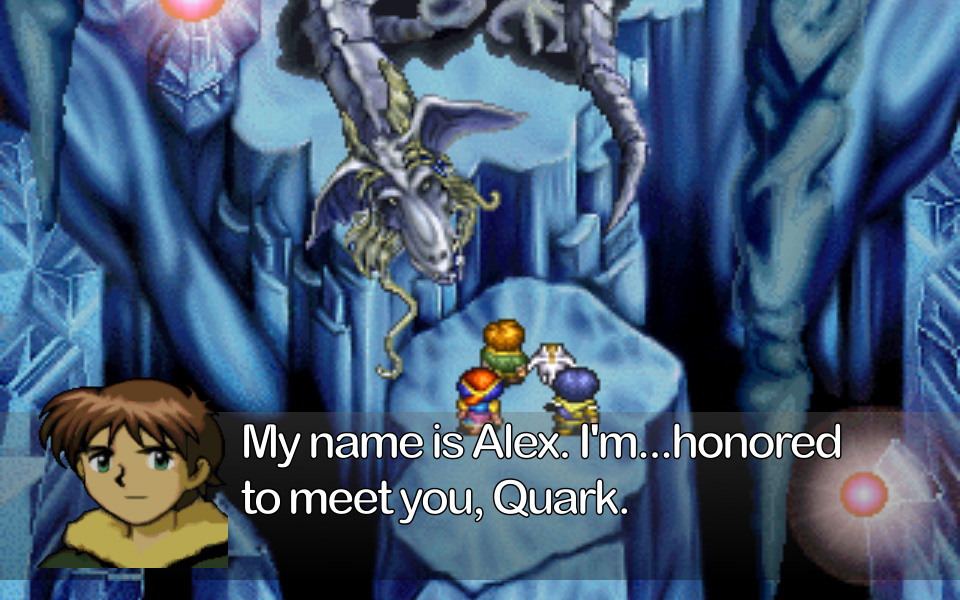 Upon completing the challenge of the ice cave — meeting Quark the Dragon in the process — Alex is told by the ancient creature that he reminds him greatly of Dyne, and that he should seek out and complete the four Dragon Trials the same as Dyne did before him. Thusly Alex leaves to seek out the four trials with the help of his friends — both fellow villagers, as well as new people he has not yet met — and along the way see the rest of the world and the other three legendary heroes that fought alongside the now dead Dyne. Before Alex’s journey is over he will go through a plot filled with numerous twists and turns, and discover the depths of an intricate conspiracy that began roughly fifteen years ago.
Upon completing the challenge of the ice cave — meeting Quark the Dragon in the process — Alex is told by the ancient creature that he reminds him greatly of Dyne, and that he should seek out and complete the four Dragon Trials the same as Dyne did before him. Thusly Alex leaves to seek out the four trials with the help of his friends — both fellow villagers, as well as new people he has not yet met — and along the way see the rest of the world and the other three legendary heroes that fought alongside the now dead Dyne. Before Alex’s journey is over he will go through a plot filled with numerous twists and turns, and discover the depths of an intricate conspiracy that began roughly fifteen years ago.
While the plot as I have presented it may seem rather generic, trope-filled, and like something that would probably prove to be predictable — and that isn’t necessarily untrue — what really makes Lunar: Silver Star Story Touch thrive is the writing through which everything is delivered. Often times in RPGs the dialogue can be delivered through dialogue which — even when well written — ends up feeling like something someone would only say in the middle of a stage performance, rather than something real people actually say to each other. Not that there’s anything necessarily wrong with the hyper-drama approach to dialogue, but Lunar — thanks in part to the now classic translation originally given to it by Working Designs back in the day — features numerous discussions that actually feel like conversations real friends would have on any given day of the week.
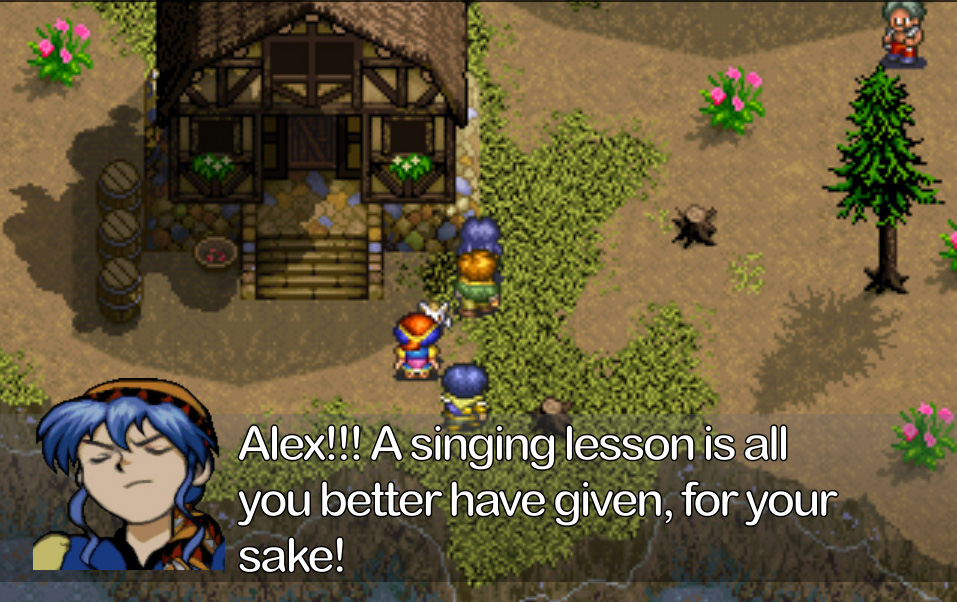 Case in point: early in the game when Ramus suggests to Alex that he help him get a Dragon Diamond from the legendary Quark, the portly youth’s father — also the village’s mayor — complains that his son needs to stop having his head in the clouds and start thinking more about the village’s future. When the manor’s house maid urges him to listen to his father, Ramus protests back, “Nana, I’m a big boy now, I can take care of myself.” To this, Nall — Alex’s pet flying fluffy white winged cat thing, known for its smart mouth and love of fish — immediately chimes in, “Yes, Nanny, Ramus is big. In fact, he’s the biggest kid I’ve ever seen!” Exchanges like this not only ensure that Lunar: Silver Star Story Touch is usually genuinely hilarious, but furthermore makes all the characters in the fantasy world feel as if they’re real people one might actually meet.
Case in point: early in the game when Ramus suggests to Alex that he help him get a Dragon Diamond from the legendary Quark, the portly youth’s father — also the village’s mayor — complains that his son needs to stop having his head in the clouds and start thinking more about the village’s future. When the manor’s house maid urges him to listen to his father, Ramus protests back, “Nana, I’m a big boy now, I can take care of myself.” To this, Nall — Alex’s pet flying fluffy white winged cat thing, known for its smart mouth and love of fish — immediately chimes in, “Yes, Nanny, Ramus is big. In fact, he’s the biggest kid I’ve ever seen!” Exchanges like this not only ensure that Lunar: Silver Star Story Touch is usually genuinely hilarious, but furthermore makes all the characters in the fantasy world feel as if they’re real people one might actually meet.
Accompanying the stellar translation, which really brings all of the NPCs and main cast alive, Lunar’s story is also presented to players via more than an hour of hand drawn FMVs that were animated by GONZO for the original PS1 edition. As an extra bonus for those playing the game on their iOS devices, the FMVs – taking advantage of the massive advancements in compression technology since the mid nineties – have been presented here with none of the jerkiness or artifacts that were painfully present back in the day. The only major difference one can spot in the new release’s FMVs — other than the enhanced clarity and smoothness — is that they now use a mostly differently cast of voice actors than the PS1 release, which originally featured various friends and family of the Working Designs staff.
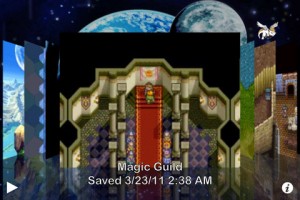 Now normally I prefer to wait until the end of a review before I start discussing how a game looks, but I’m going to cover that next because in the RPG genre — where your direct interaction is more limited — you focus far more on the graphics than you normally would. There is actually an impressive amount of variety in how Lunar’s different locales appear, as well as a wide array of graphical touches — belying a real attention to detail — strewn about. House are filled with lots of rooms, and contain as many beds as there are people living there; various tables within a bar will all have completely different assortments of items stacked on top of them, and people sitting at those bar tables will even be animated actually drinking from a mug; town drunks will actually be shown sprawled out on the floor in a state of collapse, rather than just being rendered in the typical oldschool RPG method of simply showing them standing there; each and every town itself will have a completely different look and feel to it, rather than just having a different arrangement of buildings; and all of this graphical flair even carries over to Lunar’s battle engine.
Now normally I prefer to wait until the end of a review before I start discussing how a game looks, but I’m going to cover that next because in the RPG genre — where your direct interaction is more limited — you focus far more on the graphics than you normally would. There is actually an impressive amount of variety in how Lunar’s different locales appear, as well as a wide array of graphical touches — belying a real attention to detail — strewn about. House are filled with lots of rooms, and contain as many beds as there are people living there; various tables within a bar will all have completely different assortments of items stacked on top of them, and people sitting at those bar tables will even be animated actually drinking from a mug; town drunks will actually be shown sprawled out on the floor in a state of collapse, rather than just being rendered in the typical oldschool RPG method of simply showing them standing there; each and every town itself will have a completely different look and feel to it, rather than just having a different arrangement of buildings; and all of this graphical flair even carries over to Lunar’s battle engine.
In Lunar: Silver Star Story Touch you do not encounter battles at random like in most other RPGs, but rather instead they occur when you bump into one of the many enemies you can see freely moving about the game’s various dungeons. This simultaneously makes it easier to find battles when you actually want to go grinding, as well as permits crafty players a chance to avoid non-boss battles entirely by running around the opposition. To further help the player decide whether or not he wants to charge head long into a fight, the appearance of enemy units seen moving about dungeons will be based on the most powerful monster in that group.
 The second surprise players will face is that while Lunar uses a traditional turn based combat system, all of the game’s fights take place on a grid instead of the classic method of having the heroes and monsters line up at two different ends of a field. In Lunar both heroes and monsters will have to actually reach the square their desired target is in before they can attack it, and no one is allowed to move through a square someone else is occupying. To this end melee characters will need to consider how far away their opposition is before they attempt to lash out at the enemy, although it is amusing when the enemy forgets to do this and then tries/fails to attack someone you have positioned at the back of the field. As an accompaniment to this unique set up, Lunar’s option menu lets you directly control which square — on your party’s starting half of the board — each of your heroes occupy when a battle first begins.
The second surprise players will face is that while Lunar uses a traditional turn based combat system, all of the game’s fights take place on a grid instead of the classic method of having the heroes and monsters line up at two different ends of a field. In Lunar both heroes and monsters will have to actually reach the square their desired target is in before they can attack it, and no one is allowed to move through a square someone else is occupying. To this end melee characters will need to consider how far away their opposition is before they attempt to lash out at the enemy, although it is amusing when the enemy forgets to do this and then tries/fails to attack someone you have positioned at the back of the field. As an accompaniment to this unique set up, Lunar’s option menu lets you directly control which square — on your party’s starting half of the board — each of your heroes occupy when a battle first begins.
The third way that Lunar will surprise long time RPG players is that you will never have to select who you want to be in the party, for everyone currently with you — as determined by the present flow of the plot – will always been in your party’s active ranks. During the course of the game your party will be filled with a variety of different characters with both unique personalities and ability sets, some of whom will be more long term additions than others. Even Nall, Alex’s flying cat-like pet, is present for each and every battle — where he can be seen flitting about the sidelines — and the fluffy smart aleck will even occasionally provide free resurrections for fallen heroes by poking them until they wake back up.
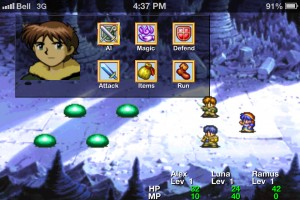 On a somewhat slightly annoying — although admittedly more realistic — note, each of your heroes will have their own personal limited inventory space for carrying consumable items into battle. Of course, they are always free to restock from anything Nall is carrying in his nearly limitless inventory space once a battle is done (just never expect to access any item he is holding while a fight is still in session). This is much less of a problem in the iOS port of Lunar than it was in the PS1 version that previously got released in the US, thanks to the absence of Working Designs’ ‘fixes’ that heavily shifted the game to a far more hardcore difficulty than had been intended by the original developers.
On a somewhat slightly annoying — although admittedly more realistic — note, each of your heroes will have their own personal limited inventory space for carrying consumable items into battle. Of course, they are always free to restock from anything Nall is carrying in his nearly limitless inventory space once a battle is done (just never expect to access any item he is holding while a fight is still in session). This is much less of a problem in the iOS port of Lunar than it was in the PS1 version that previously got released in the US, thanks to the absence of Working Designs’ ‘fixes’ that heavily shifted the game to a far more hardcore difficulty than had been intended by the original developers.
Since the tap based controls in Lunar’s battle engine are essentially self apparent at first glance, I will instead move on to covering the matter of how the game’s controls work outside of combat. The first method one can use to control where Alex and his party moves is by tapping somewhere on the screen, after which his entire entourage will attempt to walk to designated spot. I use the word attempt here because Alex and company are just as likely to get stuck on some random bit of scenery along the way as they are to reach their target, especially in towns where there are lots of scenery bits all over the place. The second non-combat control method in Lunar involves a virtual joystick that can be summoned by tapping and holding anywhere on the screen, and will always suffice for those times you get so stuck that the standard tapping technique stops working.
 With a virtual joystick present, one might begin to wonder why they can’t also just have an option present to simply make a fixed position d-pad appear in the bottom left of the playing field. Well — to be honest — Lunar: Silver Story Touch actually does have a fixed location D-Pad option built in, except it has been implemented through the most the bizarre of methods. If you turn your iOS unit — such that it is sitting in your hands vertically — then the entirety of the game playing field will scrunch up into the top half of the screen, all while a completely fixed button control array appears on the screen’s bottom half. For the life of me, I can not begin to fathom why they did this.
With a virtual joystick present, one might begin to wonder why they can’t also just have an option present to simply make a fixed position d-pad appear in the bottom left of the playing field. Well — to be honest — Lunar: Silver Story Touch actually does have a fixed location D-Pad option built in, except it has been implemented through the most the bizarre of methods. If you turn your iOS unit — such that it is sitting in your hands vertically — then the entirety of the game playing field will scrunch up into the top half of the screen, all while a completely fixed button control array appears on the screen’s bottom half. For the life of me, I can not begin to fathom why they did this.
Outside of the oddities present in how you make your party walk from one location to another, the only real bug I could find in Lunar: Silver Star Story Touch is one where the game will start running slowly if you play it long enough. I am not entirely sure what brings this bug on as sometimes it took about 30 minutes to manifest, where as other times it took closer to two hours before things started to become sluggish. While the game will continue to slow down more and more with the passage of time once the bug kicks in, its a minor issue since you are free to save the game absolutely anywhere so long as you aren’t currently in a battle. For those of you who aren’t aware, the method for force closing software involves double tapping the home button to bring up the list of running processes and then holding down on them until red x’s appear in the corner of each icon (at which point it should be obvious what the red x itself does).
iFanzine Verdict: With more than 60 hours of gameplay, and production values out the wazoo, Lunar: Silver Star Story Touch easily creams any RPG ever designed as an original game for iOS straight up. If you’ve never played Lunar before, then you truly owe it to yourself to experience the splendor of the games’ package at least once (and now you won’t have to spend 60 hours in front of your TV to do so). For those of you who already experienced the game back in the day, I promise you that the game is just as much fun now as it was back then (possibly even more so now that Working Designs’ patience trying ‘fixes’ are all gone).

